
Pleurotus ostreatus, the oyster mushroom, oyster fungus, or hiratake, is a common edible mushroom. It was first cultivated in Germany as a subsistence measure during World War I and is now grown commercially around the world for food. It is related to the similarly cultivated king oyster mushroom. Oyster mushrooms can also be used industrially for mycoremediation purposes.

Panaeolus cinctulus, syn. Panaeolus subbalteatus, commonly known as the banded mottlegill, weed Panaeolus or subbs is a very common, widely distributed psilocybin mushroom. According to American naturalist and mycologist David Arora, Panaeolus cinctulus is the most common psilocybin mushroom in California.

Trametes versicolor – also known as Coriolus versicolor and Polyporus versicolor – is a common polypore mushroom found throughout the world. Meaning 'of several colors', versicolor reliably describes this fungus that displays a variety of colors. For example, because its shape and multiple colors are similar to those of a wild turkey, T. versicolor is commonly called turkey tail. A similar looking mushroom, commonly called false turkey tail, which is from a different order, may sometimes be confused with the turkey tail mushroom due to appearance. Another lookalike is the multicolor gill polypore.

Pluteus cervinus, also known as Pluteus atricapillus and commonly known as the deer shield or the deer or fawn mushroom, is a mushroom that belongs to the large genus Pluteus. It is found on rotten logs, roots and tree stumps and is widely distributed. It can also grow on sawdust and other wood waste. Being very variable in appearance, it has been divided into several varieties or subspecies, some of which are sometimes considered species in their own right. It is edible when young, but considered by some to be of poor quality and is not often collected for the table.
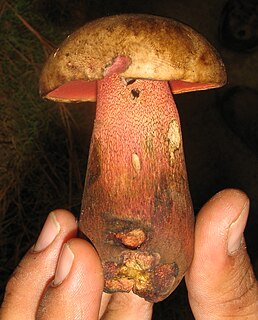
Rubroboletus pulcherrimus—known as Boletus pulcherrimus until 2015—is a species of mushroom in the family Boletaceae. It is a large bolete from Western North America with distinguishing features that include a netted surface on the stem, a red to brown cap and stem color, and red pores that stain blue upon injury. Until 2005 this was the only bolete that has been implicated in the death of someone consuming it; a couple developed gastrointestinal symptoms in 1994 after eating this fungus with the husband succumbing. Autopsy revealed infarction of the midgut.
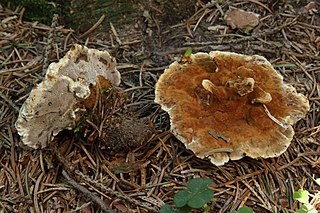
Onnia tomentosa is a species of fungus in the family Hymenochaetaceae commonly known as the woolly velvet polypore. It is frequently found in coniferous forests at higher altitudes, often growing in large groups, rather rare at lower altitudes. It is a plant pathogen, and causes tomentosus root rot, primarily in spruce. It was formerly known as Inonotus tomentosum (Fr.) Teng until molecular phylogenetic analysis led to major revisions in the classification of the Hymenochaetaceae.

Gyromitra infula, commonly known as the hooded false morel or the elfin saddle, is a fungus in the family Helvellaceae. The dark reddish-brown caps of the fruit bodies develop a characteristic saddle-shape in maturity, and the ends of both saddle lobes are drawn out to sharp tips that project above the level of the fruit body. The stipe is white or flushed pale brown, smooth on the outside, but hollow with some chambers inside. It is found in the Northern Hemisphere, usually in the late summer and autumn, growing on rotting wood or on hard packed ground. G. infula is considered inedible as it contains the toxic compound gyromitrin which, when metabolized by the body, is converted into monomethylhydrazine, a component of some rocket fuels. The toxin may be removed by thorough cooking. Gyromitra fungi are included in the informal category "false morels".

Gymnopilus sapineus, commonly known as scaly rustgill, is a small and widely distributed mushroom which grows in dense clusters on dead conifer wood. It has a rusty orange spore print and a bitter taste. This species does not stain blue and lacks the hallucinogen psilocybin.

Sarcodon imbricatus, commonly known as the shingled hedgehog or scaly hedgehog, is a species of tooth fungus in the order Thelephorales. The mushroom is edible. Many sources report it has a bitter taste, but others have found it delicious and suspect that the bitter specimens may be similar related species. The mushroom has a large, brownish cap with large brown scales and may reach 30 cm (12 in) in diameter. On the underside it sports greyish, brittle teeth instead of gills, and has white flesh. Its spore print is brown. It is associated with spruce (Picea), appearing in autumn. It ranges throughout North America and Europe, although collections from the British Isles are now assigned to the similar species Sarcodon squamosus.
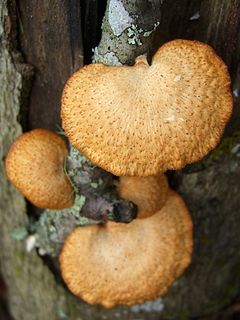
Polyporus alveolaris, commonly known as the hexagonal-pored polypore, is a species of fungus in the genus Polyporus. It causes a white rot of dead hardwoods. Found on sticks and decaying logs, its distinguishing features are its yellowish to orange scaly cap, and the hexagonal or diamond-shaped pores. It is widely distributed in North America, and also found in Asia, Australia, and Europe.

Grifola frondosa is a polypore mushroom that grows at the base of trees, particularly old growth oaks or maples. It is typically found in late summer to early autumn. It is native to China, Europe, and North America.
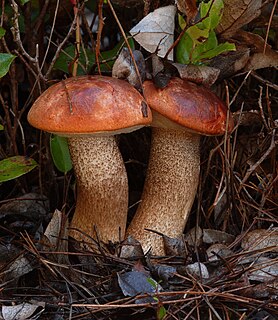
Leccinum manzanitae is an edible species of bolete fungus in the family Boletaceae. Described as new to science in 1971, it is commonly known as the manzanita bolete for its usual mycorrhizal association with manzanita trees. Its fruit bodies (mushrooms) have sticky reddish to brown caps up to 20 cm (8 in), and its stipes are up to 16 cm (6.3 in) long and 3.5 cm (1.4 in) thick. They have a whitish background color punctuated with small black scales known as scabers. Found only in the Pacific Northwest region of the United States and Canada, it is the most common Leccinum species in California. The mushroom is edible, although opinions vary as to its quality. L. manzanitae can be usually distinguished from other similar bolete mushrooms by its large size, reddish cap, dark scabers on a whitish stipe, and association with manzanita and madrone.

Hygrophorus subalpinus, commonly known as the subalpine waxycap, is a species of white snowbank fungus in the family Hygrophoraceae. Found in the mountains of western North America, it is found growing on the ground under conifers, usually near snowbanks.

Caloboletus rubripes, commonly known as the red-stipe bolete or the red-stemmed bitter bolete, is a mushroom in the family Boletaceae. It was known as Boletus rubripes until 2014. Fruit bodies (mushrooms) are robust, with caps up to 18 cm in diameter, atop thick stipes 5–12 cm long. Mushrooms are non-toxic, but is so bitter as to be inedible. The mushroom flesh has a very strong bluing reaction when cut or damaged. and forms mycorrhizal relationships, primarily with conifers. It can be differentiated from similar boletes by its cap color and non-reticulate stipe.
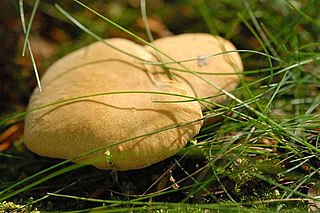
Cerioporus leptocephalus, commonly known as blackfoot polypore, is an inedible species of mushroom in the genus Cerioporus. It usually grows on the branches of broad leaved trees. Formerly placed in the genus Polyporus, this species was moved into Cerioporus in 2016.

Agaricus hondensis, commonly known as the felt-ringed agaricus, is a species of fungus in the family Agaricaceae. The species was officially described in 1912 by mycologist William Alphonso Murrill, along with three other Agaricus species that have since been placed in synonymy with A. hondensis. Found in the Pacific Northwest region of North America, A. hondensis fruits in the fall under conifers or in mixed forests.

Cortinarius camphoratus, commonly known as the goatcheese webcap, is an agaric fungus in the family Cortinariaceae. The fungus is found in Europe and North America, where its fruit bodies (mushrooms) grow on the ground in a mycorrhizal association with spruce and firs in coniferous forests. Mushrooms are characterized by pale blue lilac colors when young, and a strong distinctive odor. Sources disagree as to the edibility of the mushroom, but they are generally not recommended for eating.

Royoporus badius or Picipes badius, commonly known as the black-footed polypore or black-leg, is a species of fungus in the family Polyporaceae. It causes a white rot of hardwoods and conifers. The species is found in temperate areas of Asia, Australia, Europe, and North America. It has a dark brown or reddish-brown cap that reaches a diameter of 25 cm (9.8 in), and a stipe that is often completely black or brown at the top and black at the base.

Imleria badia, commonly known as the bay bolete, is an edible, pored mushroom found in Eurasia and North America, where it grows in coniferous or mixed woods on the ground or on decaying tree stumps, sometimes in prolific numbers. Both the common and scientific names refer to the bay- or chestnut-coloured cap, which is almost spherical in young specimens before broadening and flattening out to a diameter up to 15 cm (6 in). On the cap underside are small yellowish pores that turn dull blue-grey when bruised. The smooth, cylindrical stipe, measuring 4–9 cm long by 1–2 cm thick, is coloured like the cap, but paler. Some varieties have been described from eastern North America, differing from the main type in both macroscopic and microscopic morphology.

Stropharia caerulea, commonly known as the blue roundhead, is an inedible species of agaric fungus in the family Strophariaceae. It is a common species found in Europe and North America, where it grows as a saprophyte in meadows, roadsides, hedgerows, gardens, and woodchip mulch. S. caerulea was officially described to science in 1979, although it was known to be a distinct species for about two centuries before that. The taxon Stropharia cyanea, as defined by Risto Tuomikoski in 1953, and used by several later authors, is a synonym of S. caerulea.




















